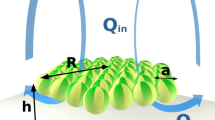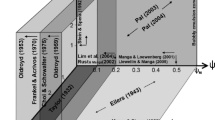Abstract
The coalescence of drops, larger than microscale vortices, induced by velocity pulsations in concentrated emulsions is examined based on the theory of locally isotropic turbulence.
Similar content being viewed by others
Abbreviations
- n:
-
number of drops per unit volume of emulsion
- t:
-
time
- λ0 and L:
-
micro- and macroscales of turbulence
- ρe, ρc, and ρd :
-
densities of the emulsion, the continuous, and the disperse phases, respectively
- σ:
-
interphase tension
- W:
-
concentration of the dispersed phase
- DT :
-
diameter of the agitating turbine
- N:
-
rate of rotation of the turbine
- D and H:
-
diameter and height of the mixing volume
- d32 :
-
averaged volume-surface diameter of the drops
- dm :
-
maximum size of drops that are stable with respect to fragmentation
- f(W):
-
concentration dependence
- ¯v and ¯v(W):
-
averaged magnitudes of the pulsation velocity in finely dispersed and coarsely dispersed emulsions
- ¯gq and θ:
-
rates of collisions and coalescence of drops
- tc and θc :
-
time and rate of circulation
- ReM :
-
Reynolds number of mixer
- μe :
-
effective viscosity of the emulsion
- Kv :
-
constant describing the efficiency of collisions drops induced by velocity pulsations
- Fv(W) and Fg(W):
-
functional relations between the rate of coalescence and concentration of drops in the inertial and gradient regimes
Literature cited
A. N. Kolomogorov, “Fragmentation of drops in a turbulent flow,” Dokl. Akad. Nauk SSSR,66, No. 5, 825–828 (1949).
J. Hinze, “Fundamentals of hydrodynamic mechanism of splitting in dispersion process,” AIChE J.,8, No. 4, 289–295 (1962).
P. H. Calderbank, “Physical rate processes in industrial fermentation. Part I. The interfacial area in gas-liquid contacting with mechanical agitation,” Trans. Inst. Chem. Eng.,36, 443–459 (1958).
D. Brown and K. Pitt, “Drop size distribution of stirred noncoalescing liquid-liquid systems,” Chem. Eng. Sci.,27, 577–583 (1972).
J. Mlynek and W. Resnik, “Drop size in an agitated liquid-liquid system,” AIChE J.,18, No. 1, 122–127 (1972).
C. A. Coulaglou and L, L. Tavlarides, “Drop size distributions and coalecence frequencies of liquid-liquid dispersions in flow vessels,” AIChE J., _22, No. 2, 289–297 (1976).
S. Gnanasundaram, T. E. Degaleeson, and G. S. Laddha, “Prediction of mean drop size in bath agitated vessels,” Can. J. Chem. Eng.,57, No. 2, 141–144 (1979).
H. Chen and S. Middleman, “Drop size distribution in agitated liquid-liquid systems,” AIChE J.,13, No. 5, 989–995 (1967).
M. A. Delichatsios and R. F. Probstein, “The effect of coalescence on the average drop size in liquid-liquid dispersions,” Ind. Eng. Chem., Fund.,15, No. 2, 137–138 (1976).
T. Mišek, “Coalescence of drops in an agitated liquid-liquid extractor,” Collect. Czech. Chem. Commun.,29, No. 9, 2086–2093 (1964).
M. Doulach, “An effect of hold-up on drop sizes in liquid-liquid dispersions,” Ind. Eng. Chem., Fund.,14, No. 2, 137–138 (1975).
D. Holmes, R. Vonchen, and J. Decker, “Fluid flow in turbulent baffled tanks. I. Circulation time,” Chem. Eng. Sci.,19, No. 3, 201–208 (1964).
A. K. Rozentsvaig and L. P. Pergushev, “Coalescence of concentrated finely dispersed emulsions with turbulent agitation,” Inzh.-Fiz., Zh.,40, No. 6, 1013–1018 (1981).
J. G. Perry, Chemical Engineering Handbook [Russian translation], Vol. 2, Khimiya, Leningrad (1969).
H. Schwartzberg and R. Treybal, “Fluid particles motion in turbulent stirred tanks,” Ind. Eng. Chem., Fund.,7, 1–2 (1968).
V. G. Levich, Physicochemical Hydrodynamics, Prentice-Hall (1962).
W. J. Howarth, “Measurement of coalescence frequency in an agitated tank,” AIChE J.,13, No. 5, 1007–1013 (1967).
R. Kuboi, J. Komasawa, and T. Otake, “Collision and coalescence of dispersed drops in turbulent liquid flow,” J. Chem. Eng. Jpn.,5, No. 4, 423–424 (1972).
K. Shiloch, S. Sideman, and W. Resnik, “Coalescence and breakup in dilute polydispersions,” Can. J. Chem. Eng.,51, No. 5, 542–549 (1973).
L. P. Pergushev and A. L. Rozentsveig, “Effect of inhomogeneity of the dispersed phase on coalescence processes and mass exchange in liquid emulsions,” Zh. Prikl. Mekh. Tekh. Fiz., No. 4, 74–81 (1980).
R. Shinnar, “On the behavior of liquid dispersion in mixing vessels,” J. Fluid Mech.,10, No. 2, 259–275 (1961).
Author information
Authors and Affiliations
Additional information
Translated from Inzhenerno-Fizicheskii Zhurnal, Vol. 42, No. 1, pp. 27–33, January, 1982.
Rights and permissions
About this article
Cite this article
Rozentsvaig, A.K. Coalescence of coarsely dispersed concentrated emulsions with turbulent agitation. Journal of Engineering Physics 42, 19–24 (1982). https://doi.org/10.1007/BF00824984
Received:
Issue Date:
DOI: https://doi.org/10.1007/BF00824984




